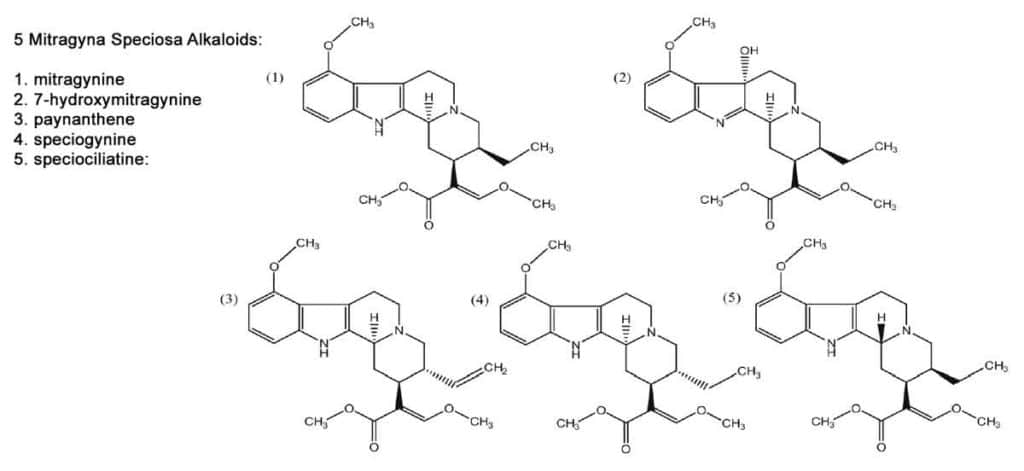ALKALOIDS COMMON TO MOST KRATOM SAMPLES
With a decade of testing Kratom, by both third party labs and in house (once we built our beyond-compliant testing lab), we’ve found some commonality in terms of alkaloid content in the numerous varieties of Mitragyna speciosa that has passed through our lab.

Mitragyna speciosa 5 common alkaloids
In a quick list, here’s what we’ve found:
Kratom from Bali:
- mitragynine
- 7-hydroxymitragynine
- speciogynine
- speciociliatine
- paynantheine
Kratom from Malaysia (region):
- mitragynine
- 7-hydroxymitragynine
- ajmalicine
- paynantheine
- speciogynine
- speciociliatine
Kratom from Thailand:
- 7-hydroxymitragynine
- mitragynine
- paynantheine
- speciogynine
- speciociliatine
Kratom from Papua New Guinea
- 7-hydroxymitragynine
- mitragynine
- paynantheine
- speciogynine
- speciociliatine
- specionoxeine
So, there are 5 alkaloids that we’ve found that are commonly present across most major varieties of Kratom. In general, in order of abundance, these are mitragynine, 7-hydroxymitragynine, speciogynine, speciociliatine, and paynantheine. We are able to secure reference samples for both mitragynine and 7-hydroxymitragynine, which means we can offer quantitative tests for these materials. In other words, we can tell you exactly what percentage of any sample material you send us consists of mitragynine and/or 7-hydroxymitragynine.
Although we’ve found the peaks for the other 3 alkaloids we test for (paynantheine, speciogynine and speciociliatine), since there are no isolated (pure) samples for purchase from a chemical supply house, we tell IF any of these 3 alkaloids are present in samples, but we cannot tell HOW MUCH is present. We can see their relative area in relation to mitragynine, but the exact percentage would only be an educated guess.
We do offer these tests for an additional fee, but we do our best to make it clear that although we can identify the alkaloids reliably, we cannot tell you how much of those 3 there are in your sample. We can see how much there is in relation to the other alkaloids, but because it’s not a simultaneous test with the 2 major alkaloids in Kratom, we only only see a presence, and not a percentage.
We’re looking forward to any researchers isolating the additional alkaloids and then publishing tests in relation to them. Whenever we get breaks in the testing action (extremely rare these days), we’re working on proprietary extraction techniques that will reliably isolate at least the 3 additional alkaloids, but we haven’t been able to nail it down yet. If we can get a pure sample, we’ll then have a 100% reference point, and could provide percentages that would be accurate enough to get a clear idea of the relative percentages of each of the major 5 alkaloids typically present in Kratom.



